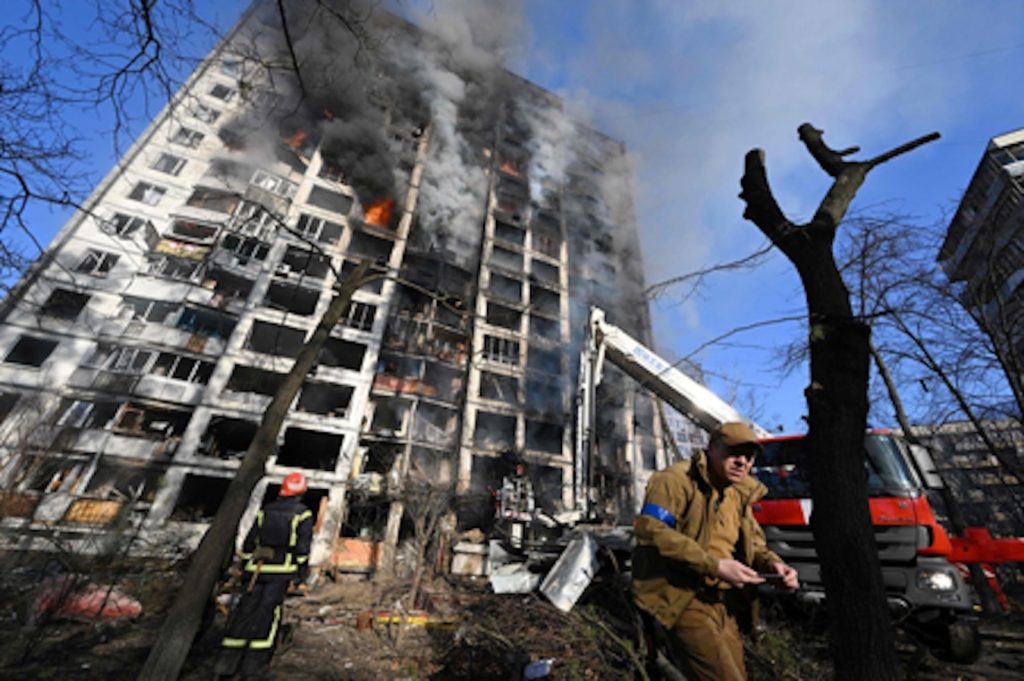Two-Month Review and Update
By: The Council on Foreign Relations
WASHINGTON, April 24, 2022 – Since Russia launched a full-scale military invasion into Ukraine on February 24, 2022, fighting has caused over nine hundred civilian deaths and pushed millions of Ukrainians to flee to nearby countries — the majority of whom have arrived in Poland, a NATO country where U.S. troops are preparing to offer assistance to refugees.
In October 2021, Russia began moving troops and military equipment near its border with Ukraine, reigniting concerns over a potential invasion.
Commercial satellite imagery, social media posts, and publicly released intelligence from November and December of 2021 showed armor, missiles, and other heavy weaponry moving toward Ukraine with no official explanation.

December 2021: 100,000+ Russian Troops
By December, more than one hundred thousand Russian troops were in place near the Russia-Ukraine border.
U.S. intelligence officials warned that Russia may be planning an invasion for early 2022.
In mid-December 2021, Russia’s foreign ministry issued a set of demands calling for the United States and the North Atlantic Treaty Organization (NATO) to cease any military activity in Eastern Europe and Central Asia…
And, to commit against further NATO expansion toward Russia, and to prevent Ukraine from joining NATO in the future.
The United States and other NATO allies rejected these demands and warned Russia they would impose severe economic sanctions if Russia invaded Ukraine.
The United States sent additional military assistance to Ukraine, including ammunition, small arms, and other defensive weaponry.
In early February 2022, U.S. President Joe Biden ordered around three thousand U.S. troops to deploy to Poland and Romania—NATO countries that border Ukraine—to counter Russian troops stationed near its border with Ukraine and reassure NATO allies.
Satellite imagery showed the largest deployment of Russian troops to its border with Belarus since the end of the Cold War. Negotiations between the United States, Russia, and European powers—including France and Germany—did not result in a resolution.
While Russia released a statement claiming to draw down a certain number of troops, reports emerged of an increasing Russian troop presence at the border with Ukraine.
In late February 2022, the United States warned that Russia intended to invade Ukraine, citing Russia’s growing military presence at the Russia-Ukraine border.
Russian President Vladimir Putin then ordered troops to Luhansk and Donetsk, separatist regions in Eastern Ukraine partly controlled by Russian-backed separatists, claiming the troops served a “peacekeeping” function.
The United States responded by imposing sanctions on the Luhansk and Donetsk regions and the Nord Stream 2 gas pipeline a few days later.
On February 24, during a United Nations Security Council meeting to dissuade Russia from attacking Ukraine….
Putin announced the beginning of a full-scale land, sea, and air invasion of Ukraine targeting Ukrainian military assets and cities across the country.
Biden declared this attack “unprovoked and unjustified” and has since issued severe sanctions in coordination with European allies targeting four of Russia’s largest banks, its oil and gas industry, and U.S. technology exports to the country.
The United Nations, G7, EU, and other countries continue to condemn Russian actions and support Ukrainian forces. In an emergency United Nations session, 141 of 193 member states voted to condemn Russia’s invasion of Ukraine and demanded that Russia immediately cease its use of force in Ukraine.
The United States has issued escalating sanctions on the financial assets of Putin and Sergey Lavrov, Russia’s foreign minister, removing Russian banks from the global SWIFT financial messaging system, and banning U.S. imports of Russian oil and natural gas.
The U.S. continues to commit military assistance to Ukraine; following Ukrainian President Volodymyr Zelenskyy’s address to Congress on March 16, Biden announced an additional $800 million in military assistance. Just after Russia’s invasion, Biden also ordered 7,000 U.S. troops deployed to Germany.
Direct negotiations between Russia and Ukraine have continued with Russia announcing in late March 2022 that it would “reduce military activity” near Kyiv and Chernihiv.
Meanwhile, Russian forces continue to combat the Ukrainian counteroffensive in and around major Ukrainian cities, although the initial Russian invasion has appeared to slow.. Several Russian long-range missile strikes have caused significant damage to Ukrainian military assets, urban residential areas, and communication and transportation infrastructure.
Hospitals and residential complexes have also sustained shelling and bombing attacks. Civilians in Mariupol–a port city in southeastern Ukraine–have been facing an ongoing humanitarian crisis with acute shortages of food, water, and heat. Russian forces have surrounded the city for weeks with aerial bombardments that have killed hundreds of civilians.
Background
Armed conflict in eastern Ukraine erupted in early 2014 following Russia’s annexation of Crimea. The previous year, protests in Ukraine’s capital Kyiv against Ukrainian President Viktor Yanukovych’s decision to reject a deal for greater economic integration with the European Union (EU) were met with a violent crackdown by state security forces. The protests widened, escalating the conflict, and President Yanukovych fled the country in February 2014.
One month later, in March 2014, Russian troops took control of Ukraine’s Crimea region. Russian President Vladimir Putin cited the need to protect the rights of Russian citizens and Russian speakers in Crimea and southeast Ukraine.
Russia then formally annexed the peninsula after Crimeans voted to join the Russian Federation in a disputed local referendum. The crisis heightened ethnic divisions, and two months later pro-Russian separatists in the Donetsk and Luhansk regions of eastern Ukraine held a referendum to declare independence from Ukraine.
Armed conflict in the region quickly broke out between Russian-backed forces and the Ukrainian military. Moscow denied military involvement, though both Ukraine and NATO reported the buildup of Russian troops and military equipment near Donetsk and Russian cross-border shelling immediately after Russia annexed Crimea.
The conflict transitioned to an active stalemate, with regular shelling and skirmishes occurring along the front line that separated Russian- and Ukrainian-controlled border regions in the east.
Beginning in February 2015, France, Germany, Russia, and Ukraine attempted to kickstart negotiations and broker a cessation in violence through the Minsk Accords.
The agreement framework included provisions for a cease-fire, withdrawal of heavy weaponry, and full Ukrainian government control throughout the conflict zone. However, efforts to reach a diplomatic settlement and satisfactory resolution were largely unsuccessful.
In April 2016, NATO announced that the alliance would deploy four battalions to Eastern Europe, rotating troops through Estonia, Latvia, Lithuania, and Poland to deter possible future Russian aggression elsewhere in Europe, particularly in the Baltics. In September 2017, the United States also deployed two U.S. Army tank brigades to Poland to further bolster NATO’s presence in the region.
In January 2018, the United States imposed new sanctions on twenty-one individuals–including a number of Russian officials–and nine companies linked to the conflict in eastern Ukraine. In March 2018, the State Department approved the sale of anti-tank weapons to Ukraine, the first sale of lethal weaponry since the conflict began.
In October 2018, Ukraine joined the United States and seven other NATO countries in a series of large-scale air exercises in western Ukraine. The exercises came after Russia held its annual military exercises in September 2018, the largest since the fall of the Soviet Union.
Ukraine has been the target of thousands of cyber-attacks. In December 2015, more than 225,000 people lost power across Ukraine in an attack on power generation firms.
In December 2016 parts of Kyiv experienced another power blackout following a similar attack targeting a Ukrainian utility company.
In June 2017, government and business computer systems in Ukraine were hit by the NotPetya cyber-attack, which was attributed to Russia; the attack spread to computer systems worldwide and caused billions of dollars in damages.
In February 2022, Ukrainian government websites, including the defense and interior ministries, banking sites, and other affiliated organizations, were targeted by distributed-denial-of-service attacks alongside the Russian invasion.
Concerns:
The current conflict has severely strained U.S.-Russia relations and increased the risk of a wider European conflict.
Tensions are likely to increase between Russia and nearby NATO-member countries that would likely involve the United States, due to alliance security commitments.
Additionally, the conflict in Ukraine will have broader ramifications for future cooperation on critical issues like:
- Arms control
- Cyber-security
- Nuclear non-proliferation
- Energy security
- Counter-terrorism
- Political solutions in Syria, Libya, and elsewhere.




